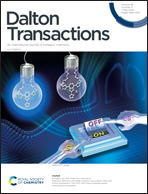Carbazole-based green and blue-BODIPY dyads and triads as donors for bulk heterojunction organic solar cells†
Abstract
Two BODIPY derivatives with one (B2) and two (B3) carbazole moieties were synthesized and applied as electron-donor materials in organic photovoltaic cells (OPV). Their optical and electrochemical properties were systematically investigated. These BODIPY dyes exhibit excellent solubility in organic solvents and present high molar extinction coefficients (1.37–1.48 × 105 M−1 cm−1) in solutions with absorption maxima at 586 nm for mono-styryl groups and at 672 nm for di-styryl groups. The introduction of the styryl moieties results in a large bathochromic shift and a significant decrease in the HOMO–LUMO energy-gaps. The BODIPY dyes show relatively low HOMO energies ranging from −4.99 to −5.16 eV as determined from cyclic voltammetry measurements. Cyclic voltammetry measurements and theoretical calculations demonstrate that the frontier molecular orbital levels of these compounds match with those of PC71BM as the acceptor, supporting their application as donor materials in solution-processed small molecule bulk heterojunction (BHJ) organic solar cells. After the optimization of the active layer, B2:PC71BM and B3:PC71BM based organic solar cells showed an overall power conversion efficiency of 6.41% and 7.47%, respectively. The higher PCE of the B3-based OSC is ascribed to the more balanced charge transport and exciton dissociation, better crystallinity and molecular packing.



 Please wait while we load your content...
Please wait while we load your content...